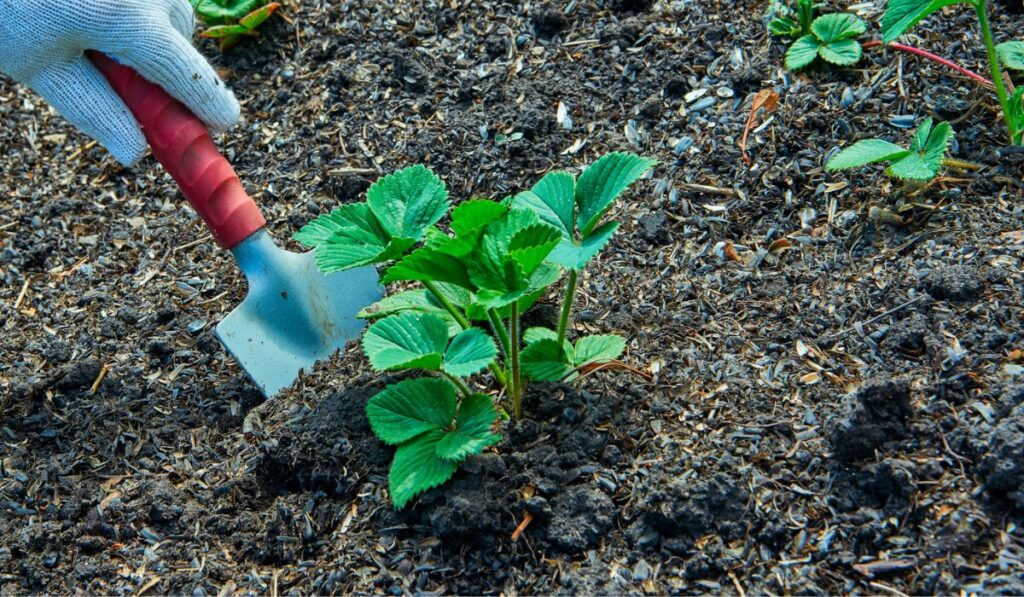No matter how you like your strawberries, there’s nothing quite like biting into a ripe, juicy strawberry that you’ve grown yourself. Strawberries are one of the easiest fruits you can grow at home, and with some know-how, you can enjoy fresh berries from your own patch for months.
Strawberries are planted in spring or fall, depending on the climate and variety. For example, June-bearing strawberries are planted in fall, while ever-bearing or day-neutral strawberries are planted six weeks before the last frost date.
Growing strawberries isn’t hard at all. But, if left to their own devices, they may take over your yard. So all you need is a little patience, some elbow grease for prepping the soil, and a sunny spot in your yard. And you’ll get to enjoy delicious strawberries in no time.
When Should You Plant Strawberries?

Strawberries have a wide planting window because there are early, mid, and late-season varieties. The earliest strawberries, called June-bearing strawberries, are typically planted in late summer to early winter. They’re pretty hardy and withstand cold. In fact, a few light touches of frost sweeten the berries.
Mid-season overbearing varieties are planted 6-8 weeks before the last frost date in spring. These varieties produce berries for the whole summer. Late-season day-neutral varieties are also planted along with the mid-season berries in March or April.
These varieties produce berries until autumn, but they’re not suitable for all areas because they can’t survive hot summers.
Apart from the natural strawberry seasons, they can do well in controlled environments like greenhouses or polytunnels. This allows you to grow strawberries year-round, no matter what the weather is like outside.
Preparing Your Soil to Plant Strawberries
Strawberries like rich, organic, and well-drained soil. The best spots are raised beds because they offer good drainage and protect the fruit from slugs or other pests lurking in the ground. However, you can plant strawberries in flat beds, containers, pots, or hanging baskets.
To prepare the soil:
- Start by removing any weeds and breaking up any large clumps of dirt with a spade or hoe.
- If the ground is very hard, loosen the top 8-10 inches with a tiller.
- Add some organic matter like well-rotted manure, compost, or leaf mold. This will help improve drainage and aeration while providing essential nutrients for the plants.
Once the soil is prepared, make raised beds or rake the soil flat if you don’t want to go through the trouble. You can add a slow-release fertilizer to the soil at this stage to give the plants a little boost.
What are June-Bearing Strawberries?
As the name suggests, June-bearing strawberries bear a large fruit crop yearly, typically in late spring or early summer. They’re commercially grown in fields, and you often see them for sale in stores.
June-bearing strawberries are planted in early fall; they start flowering in the next few months, and the fruit sets in early spring next year. Unfortunately, the first season doesn’t produce much, so the plants are usually pinched back (have the flowers removed) to focus their energies on growing.
They go into dormancy over winter and then produce a large fruit crop the following season. After that, they continue to produce a good crop for 2 or 3 years before they need to be replaced.
Usually, farmers continue to propagate June-bearing strawberries by runners (stolons) every year, so they have a constant supply of mature plants.
How Long Does it Take Strawberries to Grow?
A strawberry plant typically takes 3-4 months from seed to produce fruit. But remember that the strawberry plants grown from seeds or propagated runners may not give much fruit in the first season.
Here’s a general timeline of growth stages for June-bearing strawberries planted in late summers;
- Seedlings emerge in 2-3 weeks.
- Flowering begins in the fall, two months after planting.
- Flowers are pinched on new plants to focus on root growth.
- The plant goes through dormancy over winter.
- Fast vegetative growth over the next six months.
- 2nd season flowering in fall.
- Fruit set in early spring.
- A whole ripe crop in late spring.
- This cycle continues for 2-3 years until the plants need to be replaced.
This is just a general guide, though. The speed of growth and fruiting time changes with the variety of strawberries, climate, soil type, and growing conditions.
How to Winterize Your Strawberries

Strawberries are pretty hardy, which means they can somewhat survive cold. But if you live in an area with harsh winters, you’ll need to take extra steps to protect your plants.
In late autumn, cut back the strawberry plants to just a few inches above the soil. This will help them focus their energies on roots and crowns. One exception to this step is late-bearing varieties; they only need light pruning of dead leaves.
Warmer Climates
If you live in a warm climate, you don’t need to mulch your strawberry plants. Just weed the strawberry patch and clean and remove any remaining debris, so the pests don’t have a place to hide overwinters. You can also add a 10-10-10 fertilizer to the strawberry patch before the first frost.
Cooler Climates
In slightly colder climates, lay 2-3 inches of straw or pine needles over the ground after the ground freezes. Then cover the plant with garden fabric or a frost blanket after flowering in late autumn.
This will give them some extra protection against frost. In harsh winters, mulch heavily, about 5-6 inches before the first frost. You may also need to build a cold frame or tunnel over the strawberry patch.
Pots and Containers
Strawberries in pots or containers are more susceptible to frost. So, it’s also a good idea to bring them under a plastic shed. Pots also dry out faster, so water them regularly, even in winter. Besides that, follow the same winterization process as strawberries in the ground.
